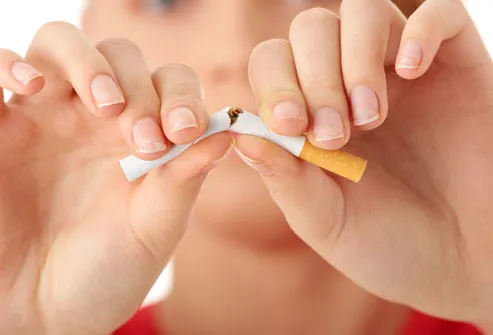Ready for some good news? Once you’ve quit smoking (and we know you can!), here’s what you can look forward to:

Three Months
Within three months of stopping smoking, the lung function (the amount and speed of air that can be inhaled and exhaled) begins to improve.
One year
During the first smoking-free year, the small hair-like cilia in the lungs improve their ability to move mucus and clean the lungs. Problems such as shortness of breath and coughing become less frequent.
Ten Years
After 10 years of not smoking, a U.S. Surgeon General's report shows that the risk of lung cancer drops to less than half that of an individual who smokes.
Women
A Lung Health Study sponsored by the National Heart, Lung, and Blood Institute (NHLBI) showed that women's lung function improved twice as much as men's during the first year after stopping smoking.
Warning
According to a 2004 U.S. Department of Health and Human Services report, "The Health Consequences of Smoking: A Report of the Surgeon General," former smokers will always have a higher risk of lung cancer than those who have never smoked.
Read more: http://www.happynews.com/living/smoking/fast-lungs-recover-quitting-smoking.htm









 We've made progress in reducing tobacco use among youth; however, far too many young people are still using tobacco. Today, more than 600,000 middle school students and 3 million high school students smoke cigarettes. Rates of decline for cigarette smoking have slowed in the last decade, and rates of decline for smokeless tobacco use have stalled completely. In addition:
We've made progress in reducing tobacco use among youth; however, far too many young people are still using tobacco. Today, more than 600,000 middle school students and 3 million high school students smoke cigarettes. Rates of decline for cigarette smoking have slowed in the last decade, and rates of decline for smokeless tobacco use have stalled completely. In addition: Young people want to fit in with their peers. Images in tobacco marketing make tobacco use look appealing to this age group.
Young people want to fit in with their peers. Images in tobacco marketing make tobacco use look appealing to this age group. The tobacco industry has stated that its marketing only promotes brand choices among adult smokers. Regardless of intent, this marketing encourages underage youth to smoke. Nearly 9 out of 10 smokers start smoking by age 18, and more than 80% of underage smokers choose brands from among the top three most heavily advertised.
The tobacco industry has stated that its marketing only promotes brand choices among adult smokers. Regardless of intent, this marketing encourages underage youth to smoke. Nearly 9 out of 10 smokers start smoking by age 18, and more than 80% of underage smokers choose brands from among the top three most heavily advertised.
